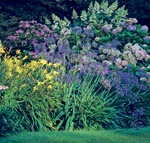Growing hydrangeas
Hydrangeas revel in wet weather, explains Michael Heseltine


For us, it was a spring to remember. Six weeks of tranquil weather in which the flowering trees and shrubs merged into a kaleidoscope of colour, free of wind, rain or frost. It is tempting now to think that we are paying a high price, as tempestuous rain persists. On looking around, I think this is the time to be staking trees and shrubs that will, doubtless, face the ferocious winds that are adding yet another hazard. Of course, rain brings its own problems. We had dug large planting holes for some yews to complete a backdrop, but our clay-based, very water-retentive soil acted as a bucket. An ominous browning of the yew leaves indicated that some of the trees were drowning. We have had this problem before then, we had to lay a land drain to take away the surplus water.
But there is always an upside. The herbaceous borders we planted in the spring have filled out well. The Fantin-Latour roses are growing with abandon and, within a year or two, will provide us with the substantial 6ft mass of pink bloom we planned.
The wet weather has also been great for hydrangeas. They arrived in this country from America and China in the 18th century, and probably rather later from Japan. We have an east-facing wall completely taken over by a self-supporting climber, Hydrangea petiolaris. In full, pale-cream flower at the end of July, it thrives in the situations that so many plants reject: north- and east-facing walls. Our two plants cover an area some 33ft by 13ft, and would happily do more.
Crûg Farm Plants, a nursery in North Wales, has an impressive range of hydrangeas, including the climber H. anomala and the evergreen H. serratifolia. It is not the easiest nursery to reach, but is a must for the collector/gardener, not only to share the enthusiasm of the owners, Sue and Bleddwyn Wynn-Jones, but to explore the very extensive offering of wild-collected species they have gathered, either on their own or with colleagues.
They list 41 wild-collected hydrangeas, along with many cultivated varieties. Order nothing until you have examined their catalogue (www.crug-farm.co.uk). Shrub hydrangeas come in all sizes, and I go for the large-leaved, medium to large shrubs, such as H.aspera, heteromalla, quercifolia and paniculata. (H. quercifolia has a bonus in its strongly coloured autumn foliage, although we find it grows slowly.) Hydrangea paniculata is a particularly valuable and showy shrub, bearing large, creamy flowers not dissimilar in shape to Buddleja davidii. Hard pruning, almost back to the old wood, does wonders for its flowering. The cultivar known as Unique is looking especially good.
But to most of us, hydrangeas are those we see in endless gardens with great mops of flowerheads, now at their peak. For colour, they range from the chalkiest white to the deepest blue, via pink, red and purple. The problem in linking colour to name, however, is that soil conditions dictate the flower colours. The more acidic the soil, the deeper the blue, and the more alkaline the soil, the deeper the reds and pinks. Our soil is close to neutral, at pH 6.7, and we have every colour of hydrangea. Most stock comes from nurseries in pots, so there is a time delay before the local soil challenges the peat-based compost and, in the end, wins.
Peter Chappell of Spinners Garden, near Lymington, introduced us to the mophead known as Merveille Sanguine, with the darkest red flowers and striking dark green leaves. And from the same source came Nachtigall, a lacecap ranging from deep pink to purple in our soil. Burncoose Nurseries in Cornwall supplied me with a fancy mophead, Frau Fujiyo, which produces large, pink sterile flowers with a pronounced white picotee edge to each petal. And two new ones this year came from John Massey of Ashwood Nurseries at Kingswinford: a deep red mophead, Harry's Red, and a deep rose or violet lacecap called Gimpel.
Exquisite houses, the beauty of Nature, and how to get the most from your life, straight to your inbox.
In truth, within their colour ranges, there are hydrangeas to meet all requirements. They are easy to propagate from cuttings, make great houseplants and are useful as dried flowers. They also like damp climates so it looks as if their moment has come.
Country Life is unlike any other magazine: the only glossy weekly on the newsstand and the only magazine that has been guest-edited by His Majesty The King not once, but twice. It is a celebration of modern rural life and all its diverse joys and pleasures — that was first published in Queen Victoria's Diamond Jubilee year. Our eclectic mixture of witty and informative content — from the most up-to-date property news and commentary and a coveted glimpse inside some of the UK's best houses and gardens, to gardening, the arts and interior design, written by experts in their field — still cannot be found in print or online, anywhere else.
